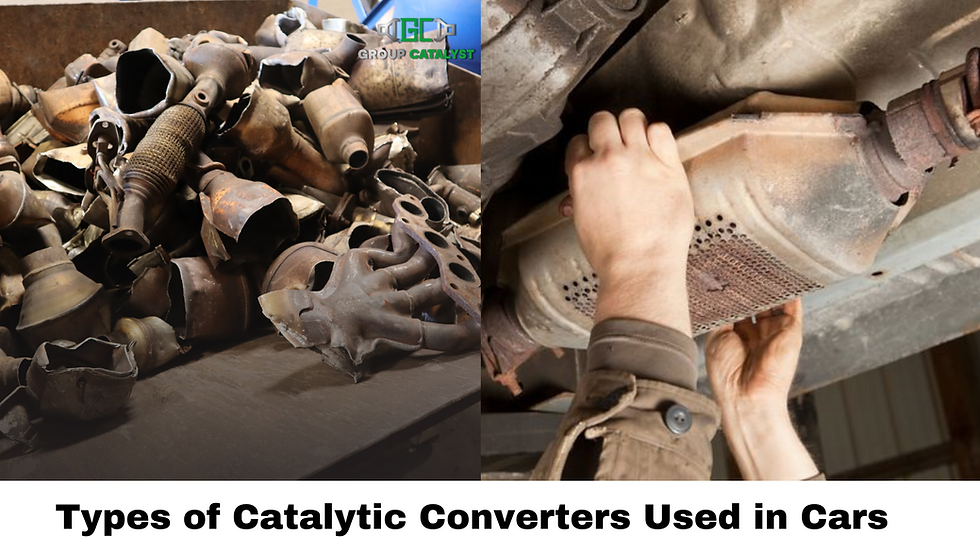Types of Catalytic Converters Used in Cars
- belanger converter
- Aug 9, 2022
- 4 min read

This is a non-technical introduction to a vitally important emission control device. If you wondered what catalytic converters do and how they work, this post will answer your questions. The origin of these emission control devices predates the modern environmental movement. However, environmental regulations are why we have catalytic converters under our cars now. Two basic designs exist, though one is now obsolete; both designs contain valuable metals that are well worth recycling. This fact goes back to an early attempt at scrubbing toxic exhaust gases from early car engines.
History and Evolution
A primitive ancestor of modern catalytic converters appeared in France in the late 19th century. This simple device used platinum group metals (PGMs) on a clay substrate. It isn’t clear if those devices ever went on earlier horseless carriages, but the design inspired future developments.
A French mechanical engineer named Eugene Houdry received the first patent for a catalytic converter device in the 1950s. His design worked to clean the exhaust from a gasoline engine. Development continued through the 1960s, though catalytic converters didn’t become practical emission control devices until the early 1970s; Engelhard Corporation launched the first production device in 1973. In the United States, environmental regulations changed, making catalytic converters mandatory as part of a larger program of emission regulations. Almost all of the catalytic converters in use today in the United States are on gasoline-powered cars but diesel engine vehicles, electrical generators, ships, and motorcycles sometimes use them too.
Catalytic Converters in Recent History
Emissions control technology has evolved, but catalytic converters haven’t changed drastically since the mid-1970s. Over time, there have been two types of converter for gasoline engines.
Two-Way Converters use two processes to neutralize some of the harmful exhaust gases an engine produces. One process uses an oxidation catalyst that converts carbon monoxide into carbon dioxide. The other process converts unburned hydrocarbons into carbon dioxide and water. The design does not work on nitrogen oxide compounds, which can create smog and acid rain alone or with other exhaust products. These were standard before 1981. Modern “lean burn” engines still use them.
Three-Way (Oxidation-Reduction) Converters work pretty much like two-way converters but also turn nitrogen oxide compounds into nitrogen and oxygen using a reduction reaction. These models have been standard on gasoline-powered cars and light trucks since 1981.
These converters are not always under a car. Some manufacturers put them closer to the engine’s exhaust manifold, so they heat up faster. High heat is critical to catalytic reactions. Some converters have electric heating coils in them, while most rely on the heat coming from the vehicle exhaust. A few vehicles have pre-converters between the engine and catalytic converter. Whatever the design, the goal is the same – to clean carbon monoxide, nitrogen oxide, and unburned hydrocarbons.
Diesel Catalytic Converters
Diesel vehicles use a different catalytic converter, a diesel oxidation catalyst. This technology works on particulate matter, carbon monoxide, and unburned hydrocarbons into carbon dioxide and water. The standard two-way converter won’t reduce the particulate matter that burning diesel fuel generates, so these converters have a third component.
Diesel engines have catalytic converters, at least in North America. These devices are like gasoline engine converters but with a major difference. Diesel engines produce tiny particles that create smog. The converters for these engines have a third element. The diesel particulate filter (DPF) traps the soot that burning diesel fuel creates. Diesel vehicles don’t use PGMs to remove nitrogen oxides, instead relying on a chemical catalyst like ammonia, usually in the form of urea, that’s injected into the exhaust stream. Diesel trucks will have this kind of catalytic converter plus a DPF. Federal law doesn’t require them, but they have been in general use for non-road vehicles since 1980 and road vehicles since 1985. They’ll likely also be found on older diesel cars, dating back to the time when manufacturers sold diesel cars in the US.
The gasoline and diesel catalytic converters all contain varying amounts of platinum group metals (PGMs) usually platinum, palladium, and rhodium. The amount varies with the model, usually 6 to 16 grams. The earliest catalytic converter models may have more, but those vehicles are getting rarer and rarer.
Recycling
Those PGMs make gas and diesel converters valuable on the scrap metal market. Most catalytic converters for gasoline engines have 6 to 16 grams of platinum, palladium, and rhodium in them. With an ounce (25 grams) of platinum being worth $900 and an ounce of palladium being worth almost $2,000, a half dozen converters can hold thousands in precious metals. Those figures mean that old converters are worth money to recyclers, which makes it worthwhile to collect and sell them.
Recycle Catalytic Converters in Bulk with Ease
Gasoline and diesel vehicles have used catalytic converters of various descriptions to cut down harmful emissions for decades. These mandatory emission control devices have generated a huge opportunity to make money by recycling the precious metals they’ve always used. Get the Group Catalyst app to quickly price your used catalytic converters and manage your inventory. Android and Apple versions are available. You can rely on us for hedging and decanning, especially if they have a large collection.




Comments